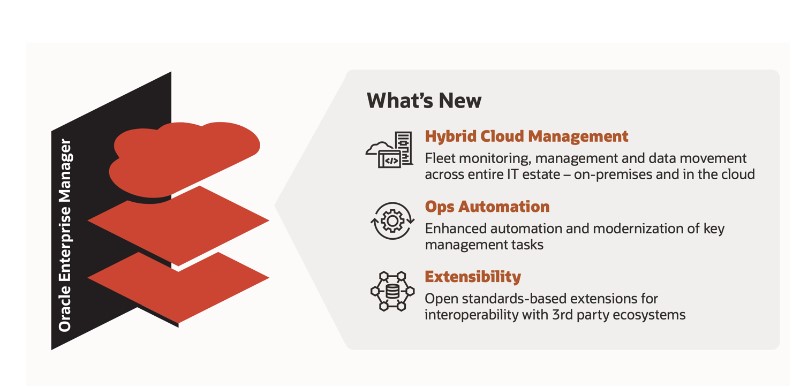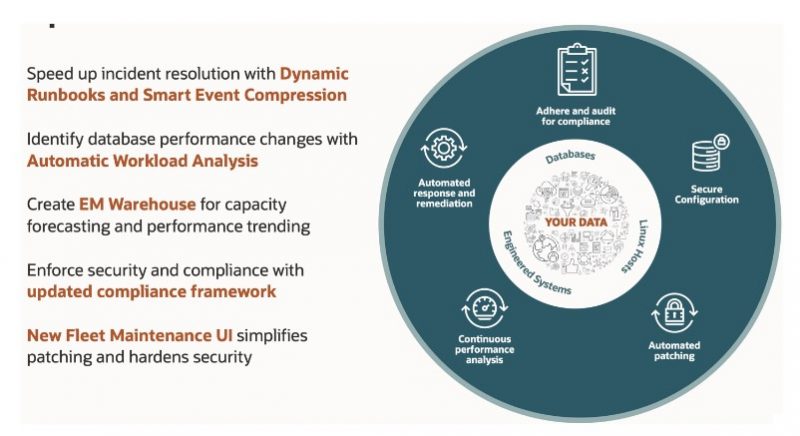 CLOUD
CLOUD
 CLOUD
CLOUD
 CLOUD
CLOUD
Oracle Corp. announced a big update to its Oracle Enterprise Manager tool today that delivers what it said are “major breakthroughs” in monitoring and management automation for Oracle environments.
Introducing the new release in a blog post, Mughees Minhas, product management vice president of enterprise and cloud manageability at Oracle, explained that Oracle Enterprise Manager is the company’s flagship management product for the entire Oracle stack and that thousands of customers use it to ensure their most critical business applications run without problems.
The new version, called Oracle Enterprise Manager 13c Release 5, was built based on feedback Oracle had received from many of its customers about the key challenges they face in managing their Oracle stacks. Minhas explained that many companies have been forced to manage their on-premises environments different from their cloud environments. That has resulted in operations and data silos that are both inefficient and error-prone, he said.
“Furthermore, it’s difficult to operate at cloud speed if you must perform a lot of manual operations,” Minhas wrote. “The more you can automate your operations, the better the quality of service you can provide. Finally, customers are constantly streamlining IT tooling and information sharing. There is a need to facilitate co-existence, interoperability and integration across different classes of tooling.”
Those are the challenges Oracle set out to address with today’s release, and the company has developed a number of new capabilities that it said will make customer’s lives much easier than before.
The new capabilities in Oracle Enterprise Manager center on three specific areas, Minhas explained: hybrid cloud management, ops automation and extensibility.

In a briefing with SiliconANGLE, Minhas explained that hybrid cloud management has become a big focus for the company because the majority of its customers now operate hybrid or what the company calls mixed IT environments.
“They’re going to stay hybrid for a very, very long time,” he added. “Ultimately companies will use cloud management tools to manage [both] on-premises and cloud operations.”
Minhas said Oracle Enterprise Manager was the logical tool for Oracle to use to address cloud management. While the product started out as a simple Oracle database manager, he explained that it has since evolved to cover the company’s entire product portfolio. “Customers use it to manage their Oracle stack from OS to virtualization to database, to mid-tier and applications,” he said.
With today’s release, though, customers can use it to manage more than just their Oracle stacks, Minhas said. He explained in the blog post that Oracle Enterprise Manager enables users to manage targets running anywhere, in both on-premises data centers and in the cloud.
Existing best practices, scripts and jobs can be applied to cloud resources in the same way they’re applied to on-premises resources. And specifically for Oracle Cloud Infrastructure resources, he added, Enterprise Manager now understands the cloud-native application programming interfaces for management operations and leverages those to provide a more seamless experience across those environments.
One of the key new hybrid cloud management capabilities is the DB Migration Workbench, which enables databases to be moved among on-premises, Oracle Cloud Infrastructure and other clouds, Minhas wrote. And post-migration, it uses SQL Performance Analyzer feature to makes sure the workload on the migrated platform performs well.

“We’re really trying to ease [customers] transition to the cloud,” Minhas told SiliconANGLE. “The stuff we’re managing could be Oracle Cloud or AWS or whatever. We consider ourselves to be a multicloud product, meaning any of the big cloud vendors.”
On the ops automation side, Minhas wrote that Oracle has added a number of new capabilities that aim to provide better operations automation. They include a new Smart Event Compression capability that automatically groups separate but related events into a single incident to help teams better triage, respond and manage any incidents that occur. Then, to speed up incident resolution, Oracle has come up with something called Dynamic Runbooks that encapsulate subject matter expertise for diagnosing and resolving any problems as actionable Runbook procedures
“In this release, we allow these teams to create these runbook procedures directly inside EM,” Minhas wrote. “This allows teams to encapsulate in EM their operational expertise in diagnosing and resolving incidents.”
With regard to performance management, the Automatic Workload Analysis feature allows Oracle Enterprise Manager to constantly compare current database performance with the baseline workload, and highlights any divergence from this that may affect its execution. The new EM Warehouse functionality meanwhile continuously extracts data from Oracle Enterprise Manager and dumps it into a database so it can be analyzed separately, without impacting its monitoring and management operations.
“On this data lake you can do performance trending, you can do capacity planning, and any other kind of analysis using your tool of choice,” Minhas wrote.

Regarding the improvements in extensibility, Oracle has made it possible to use REST APIs to execute management operations within Enterprise Manager, so the service can now be invoked from various third-party automation tools, including Ansible, Chef, Puppet and Terraform. And for those enterprises that may have multiple Oracle Enterprise Manager deployments to support different parts of their business, the EM Federation console acts as a single pane of glass for monitoring and incident management across those various Enterprise Manager sites.
Minhas said Enterprise Manager also has a revamped dashboard that includes the native capability to create user-defined dashboards using out-of-the-box widgets for data visualization. Finally, the new release comes with more flexible deployment options with higher availability and newly enhanced self-monitoring and diagnostics tools.
Constellation Research Inc. analyst Holger Mueller, who was briefed on the new release, told SiliconANGLE that everything appears to be coming together for Oracle with its autonomous stack, cloud infrastructure and software-as-a-service offerings.
“With Oracle Enterprise Manager 13C Release 5, the company is adding some key observability capabilities not only for its traditional on-premises and cloud platforms, but also for competitors’ clouds too,” Mueller said. “That is important for teams that need to manage, operate and secure next-generation application platforms. The single pane of glass with consistent analysis and management makes Oracle Enterprise Manager a very strong contender.”
Oracle said customers can expect the new features to be “delivered on a monthly cadence,” rolled out over the next four to five months.
With reporting from Robert Hof
THANK YOU